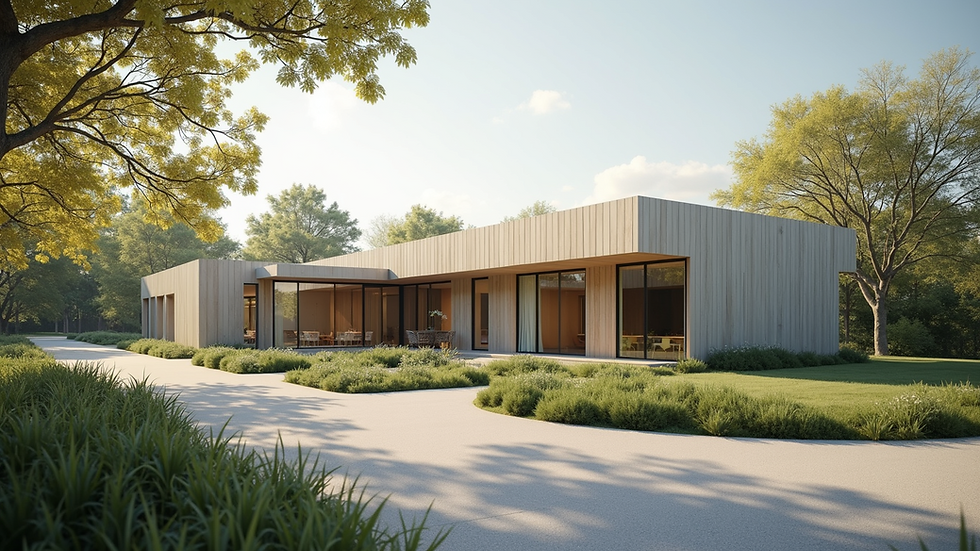Emerging Trends in the Construction Sector: Innovations and Future Directions
- Jul 24, 2025
- 4 min read
The construction industry is on the cusp of significant transformation. As we move further into the 21st century, emerging trends and technologies are shaping how we design, build, and maintain infrastructure. This blog post explores the innovations driving this evolution and presents insights into future directions that industry professionals should monitor.
Sustainability and Green Building Practices
One of the most prominent trends in the construction industry is the move toward sustainability. As concerns about climate change rise, architects and builders are increasingly prioritizing eco-friendly practices.
Sustainable building involves using resources efficiently and minimizing environmental impact. This can include utilizing renewable energy sources, such as solar panels and wind energy, as well as implementing rainwater harvesting systems. For example, the Bullitt Center in Seattle is renowned for its net-zero energy usage, making it one of the greenest commercial buildings in the world.

Additionally, green building certifications like LEED (Leadership in Energy and Environmental Design) are encouraging builders to adopt sustainable practices. In fact, according to the U.S. Green Building Council, LEED-certified buildings resulted in a 40% reduction in energy use on average when compared to traditional structures.
Digital Transformation in Construction
The rise of digital technologies is revolutionizing the construction sector. From Building Information Modeling (BIM) to augmented reality (AR) and virtual reality (VR), innovative tools are enhancing project management and collaboration.
BIM allows architects and builders to create a comprehensive 3D model of a construction project. This technology aids in visualizing the entire building before construction, leading to fewer errors and enhanced efficiency. For example, using BIM, construction teams can detect clashes between various systems (like plumbing and electrical) early in the process, thereby saving time and resources.

Moreover, AR and VR provide immersive experiences for stakeholders, enabling them to walkthrough projects before they are built. This can significantly improve client satisfaction and reduce misunderstandings between contractors, clients, and architects.
Adoption of Prefabrication and Modular Construction
Prefabrication and modular construction are gaining traction as cost-effective and efficient building methods. Prefabricated components are manufactured offsite and then assembled on location. This approach can lead to reduced construction time and waste.
According to a report from McKinsey, companies that use modular construction can reduce scheduled construction time by as much as 50%. This is particularly beneficial in urban areas where space is limited and timelines are critical.
For instance, companies like Katerra are at the forefront of modular construction, producing entire buildings in factories and completing projects much quicker than traditional methods.
Emphasis on Smart Technologies and IoT
The integration of smart technologies and the Internet of Things (IoT) is transforming how buildings operate. Smart buildings equipped with sensors and automated systems can monitor energy usage, maintenance needs, and even tenant conditions.
For example, a smart building may automatically adjust heating, ventilation, and air conditioning (HVAC) systems based on occupancy levels, leading to significant energy savings. Additionally, predictive maintenance powered by IoT can forewarn managers about potential issues before they escalate, ultimately prolonging the lifespan of building systems.
This move towards smart technologies is not just about efficiency but also adds value to properties. A study by JLL found that smart buildings can command rental premiums while also creating healthier environments for occupants.

Resilience in the Face of Climate Change
As climate change continues to pose challenges to infrastructure, there is an increasing focus on building resilience into new constructions. This means designing buildings that can withstand extreme weather conditions and natural disasters.
According to a study by the National Institute of Building Sciences, every dollar spent on hazard mitigation can save the nation an average of $6 in future disaster relief funds. Innovations in construction materials, such as hurricane-resistant roofs and earthquake-proof foundations, play a crucial role in enhancing resilience.
Build-to-last strategies encourage the selection of durable materials and include features that help protect structures from the effects of climate change. For example, in areas prone to flooding, elevating structures above potential flood levels can safeguard them from damage.
The Future: Automation and Robotics
Looking ahead, automation and robotics are poised to reshape the construction landscape significantly. Robots can automate repetitive tasks, leading to increased productivity and safety on job sites. For example, robotic bricklayers like SAM (Semi-Automated Mason) can lay bricks more rapidly and accurately than human workers.
The adoption of drones for surveying and site inspections is another innovative trend. Drones can collect data quickly and obtain real-time insights, which can be useful for tracking progress and identifying issues early on.
As the construction industry seeks to address labor shortages, automation could bridge the gap, allowing companies to complete projects more efficiently and with fewer labor resources.
Adapting to Emerging Workforce Needs
The construction industry also faces challenges related to a changing workforce. As older generations retire, there is a pressing need to attract younger workers with diverse skill sets.
This trend is prompting companies to invest in training programs and technology that appeal to younger generations. Initiatives like apprenticeship programs and partnerships with educational institutions can help bridge the skills gap.
Developing a collaborative work culture that embraces new technologies can also attract and retain talent in construction. For instance, tools that facilitate remote collaboration can appeal to tech-savvy younger workers who value flexibility in the workplace.
Staying Ahead in the Construction Sector
To keep pace with these rapid changes, industry professionals must stay informed about emerging trends. Networking at industry conferences, subscribing to relevant publications, and participating in webinars can provide valuable insights.
Furthermore, investing in continuous education and professional development will empower construction professionals to adapt to new technologies and practices effectively. By cultivating an adaptable mindset, individuals can remain competitive in this evolving landscape.
In conclusion, the construction sector is experiencing a paradigm shift driven by sustainability, technology, and new building practices. Professionals need to embrace these trends to thrive and contribute to a more resilient and efficient future in construction.
By understanding innovations, being proactive, and adapting to new technologies, you will be equipped to navigate the challenges and opportunities that lie ahead in this dynamic industry.







Comments